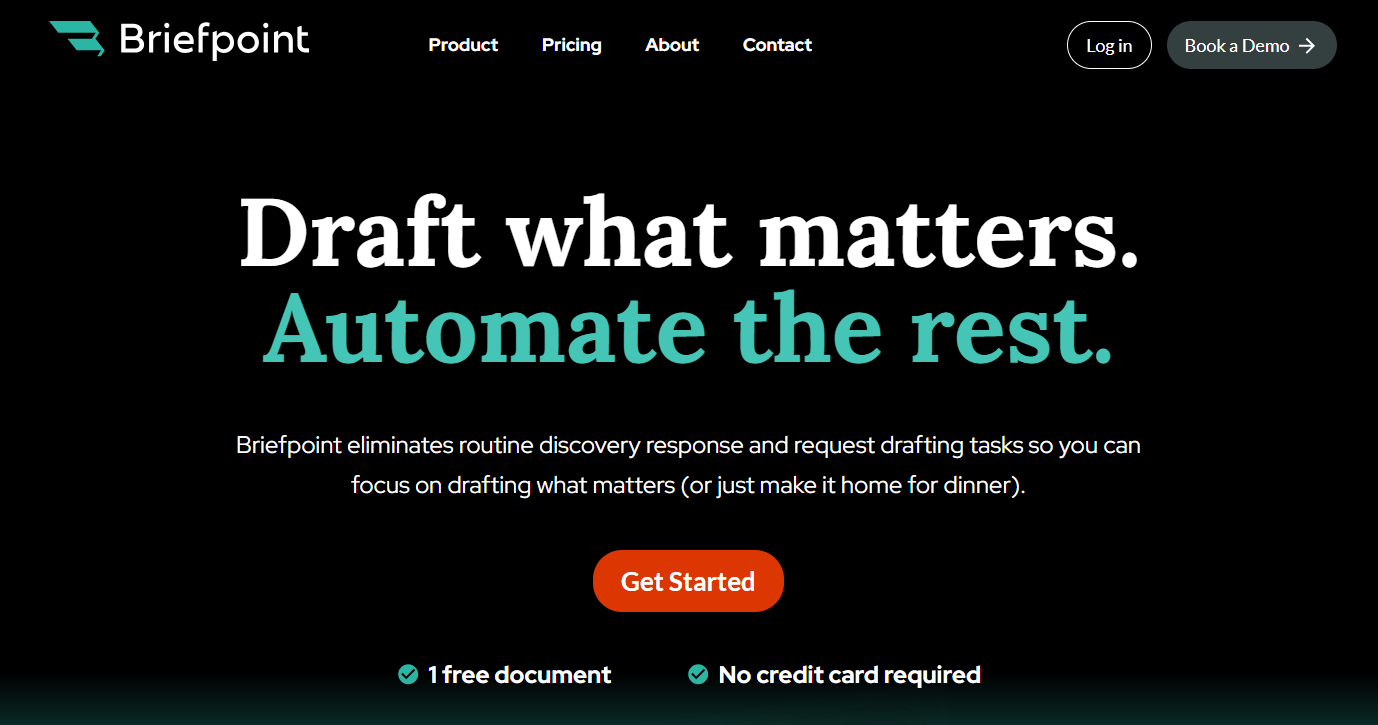How to Draft Legal Documents More Efficiently In 2025
How to Draft Legal Documents More Efficiently In 2025
You’ve got a client waiting on a contract and a draft that still needs revisions before it can go out. Half your day’s already gone, and you’re reworking language you’ve written dozens of times before. Sound familiar?
For most firms, legal drafting often moves more slowly than it should. Not because the work is complicated, but because the process hasn’t been updated.
However, with better tools and a few simple adjustments, drafting can be quicker, clearer, and far less frustrating.
This guide covers practical ways to make that shift in 2025, so you can spend less time on repetitive edits and more time on the work that actually needs your input.

What Are The Current Challenges of Manual Document Drafting?
Manual drafting continues to eat up more time than it should. On average, legal professionals spend between 40% and 60% of their working hours drafting documents and reviewing contracts.
That’s a significant portion of the day tied up in tasks that are often repetitive, slow, and prone to errors.
Here are some of the most common issues legal teams face:
- Rewriting the same content – Without templates, lawyers end up drafting similar clauses from scratch over and over.
- Small errors add up – Typos, missing sections, or inconsistent formatting can slip through when you’re working manually.
- No solid structure – Without a standard approach, each new document takes longer than necessary to build.
- Multiple drafts cause confusion – It’s easy to lose track of the latest version when documents are shared across different platforms.
- Delays in feedback – Internal and client reviews can take days, sometimes weeks, if there’s no clear process.
- Hard-to-read language – Dense legal terms slow down approval, especially for clients without legal backgrounds.
With that much time going into drafting, even small inefficiencies start to hurt.
How Can You Make Document Drafting More Efficient?
If manual drafting is slowing you down, there’s no reason to keep doing it the hard way. A few smart changes can save time, cut down on errors, and make the whole process run more smoothly. Take a look at these options:
1. Build A Foundation of Templates
One of the easiest ways to improve legal drafting is by creating a strong set of templates. Templates give you a reliable starting point, so you’re not writing every document from scratch.
Plus, they help law firms keep their writing style consistent across all written documents, from court documents to client agreements.
For example, if you’re often preparing non-disclosure agreements (NDAs), build a clean NDA template with standard clauses, placeholders for names and dates, and clear formatting. That way, you can drop in the details and move on, rather than rewriting the same words over and over.
Templates also reduce the risk of missing something important. When you’re juggling multiple legal issues at once, it’s easy to forget a key clause or overlook formatting. A good template keeps everything in order and helps avoid confusion during review or approval.
Most legal teams can benefit from having templates for things like:
- Contracts
- Discovery documents
- Engagement letters
- Pleadings
- Internal memos
Over time, you can adjust and improve them based on client needs or court requirements.
2. Invest In Document Automation Software
Legal writing takes up more time than most people think, especially when you’re repeating the same steps across different documents. Manually drafting legal texts can be time-consuming and often leads to small but costly mistakes.
Today, however, legal automation software helps reduce that friction and gives legal teams a cleaner, more dependable way to work.
These tools don’t replace your legal judgment, they support it by making the drafting process easier to manage. Instead of starting from scratch every time, you can focus on the parts that really need attention while the software handles the structure and flow.
Document automation can help with:
- Builds drafts based on templates, so you’re not rewriting basic sections
- Keeps formatting consistent to match your firm’s writing style
- Reduces manual edits that can lead to errors or missed terms
- Improves readability by using clear, pre-approved language
- Helps manage sensitive information by keeping data in one secure space
One example is Briefpoint, which uses AI to speed up legal drafting while keeping everything compliant and easy to review. It’s designed for law firms that want to create clear, accurate legal texts without wasting time on repetitive tasks.

3. Avoid Complications Whenever Possible
Why make legal documents harder to read than they need to be? Using clear and concise language helps avoid confusion and makes your writing easier to follow for both clients and reviewers.
Legal texts don’t have to be loaded with jargon to look professional. In fact, plain language often leaves a stronger impression.
When you’re dealing with business contracts or legal issues across different jurisdictions, sticking to the essential elements is key. Extra clauses or unclear terms can lead to misinterpretation or even delay approvals.
For example, if you’re drafting a service agreement for a client that operates in multiple regions, focus only on the terms relevant to each jurisdiction. Leave out anything that doesn’t apply under local regulations.
A document that’s easy to read still needs to look sharp. Keep formatting clean and maintain a professional appearance, but don’t overdo the legalese. Remember: clear beats complex every time.
4. Start Delegating Tasks
You don’t have to do everything yourself. In the legal field, time adds up fast, and trying to handle every step of document drafting on your own only slows things down.
In contrast, delegating tasks frees up your schedule and also helps others on your team build experience.
Use your time where it counts, and hand off the rest. Here are some tasks you can delegate:
- Legal research for background, citations, or updated regulations
- Collect signatures from clients, partners, or internal teams
- Fill out forms with standard details or supporting data
- Organize additional information like exhibits or attachments
- Format the main text to match your firm’s writing style
- Double-check evidence and references included in drafts
- Review earlier versions for consistency or missing content
Delegating these tasks keeps your focus on drafting solid arguments and getting documents right the first time.
5. Create a Document Drafting Workflow
A simple legal workflow helps your team stay organized and get documents done without missing key steps. It also makes your writing more consistent and easier for everyone to follow, whether it’s for court, business, or internal use.
A good workflow keeps things moving and makes sure nothing slips through the cracks. It doesn’t have to be complex—just something your team can follow without overthinking it.
Here’s a basic example:
- Gather key info like names, dates, and background from the client
- Pick the right template based on the type of document
- Write the main text, keeping it clear and focused
- Add exhibits, evidence, or any extra material needed
- Send the draft to a colleague for review
- Share with the client or other parties for feedback
- Finalize the document and collect signatures
- Store it somewhere accessible for future reference
This kind of setup helps avoid delays and confusion, especially when multiple people are involved. Once the process is in place, drafting becomes quicker and easier for everyone.

Your Drafting Process Deserves an Upgrade
Manually drafting legal documents can take up hours that could be spent on more important work (or even a normal dinner). With the right approach, you can cut down on repetitive tasks, avoid common errors, and move faster without giving up control or quality.
And if you’re serious about saving time on routine discovery tasks, Briefpoint makes that easier than ever. From generating RFP and RFA responses to keeping language consistent across your firm, it helps you focus on the work that actually matters.

Briefpoint handles the repetitive stuff, so you don’t have to.
- Draft discovery responses in minutes
- Keep objections and legal standards consistent
- Collect responses easily with Bridge
- Save time without cutting corners
Thousands of litigators already use Briefpoint to speed up their workflow, some calling it a no-brainer.
Want to see it in action? Book a demo now and see the difference for yourself.
FAQs About How to Draft Legal Documents
How do I draft a legal document?
Start by identifying the type of document you need—contract, motion, letter, or something else. Make sure to follow the correct format, include all pertinent facts, and write clearly. Use accurate terms, refer to any relevant authorities or rules, and check for confidentiality where needed. Every statement should support your purpose and be easy for all parties to follow.
Is it hard to draft legal documents?
It can be, especially without the right tools or skills. Legal drafting takes attention to detail and a solid grasp of legal concepts. But with templates, clear examples, and support from an attorney or counsel, the process becomes more manageable.
How to prepare a draft document?
Gather all necessary details, including facts, dates, and names. Choose a suitable template if available, then begin writing the main text. Focus on clarity and structure so your draft is easily understood. For litigation, be sure to include proper references to laws or prior cases involving the defendant or similar matters.
How do I make my own legal document?
You can draft your own legal document by using online tools or templates, as long as you follow the correct structure and local laws. Write in a clear tone, use active voice when possible, and review your statements for accuracy. Keep formatting clean, as it enhances readability and makes the content easier to access later if needed.
Why is legal drafting important for law firms?
Legal drafting is a core part of how law firms communicate, protect client interests, and stay compliant with regulations. Well-drafted documents help avoid disputes, set clear expectations, and reflect the firm’s professionalism. Clear structure, accurate language, and attention to detail all matter.
The information provided on this website does not, and is not intended to, constitute legal advice; instead, all information, content, and materials available on this site are for general informational purposes only. Information on this website may not constitute the most up-to-date legal or other information.
This website contains links to other third-party websites. Such links are only for the convenience of the reader, user or browser. Readers of this website should contact their attorney to obtain advice with respect to any particular legal matter. No reader, user, or browser of this site should act or refrain from acting on the basis of information on this site without first seeking legal advice from counsel in the relevant jurisdiction. Only your individual attorney can provide assurances that the information contained herein – and your interpretation of it – is applicable or appropriate to your particular situation. Use of, and access to, this website or any of the links or resources contained within the site do not create an attorney-client relationship between the reader, user, or browser and website authors, contributors, contributing law firms, or committee members and their respective employers.